Reconsidering My Run Shoe Brand
I was a frustrated runner for an entire generation. Not a run shoe generation, as in from the Brooks Glycerin 14 to a 15. The quarter-century kind of generation. Through the 90s and the aughts brands like ASICS and Brooks had the industry by the neck, making high-drop, low-forefoot-cushion shoes, and it didn’t seem like there was any prognosis for change. Then in 2010 two Frenchmen, Nico Mermoud and Jean-Luc Diard, upended everything with a shoe they made for skyrunners, but which turned out to be the template for all runners.
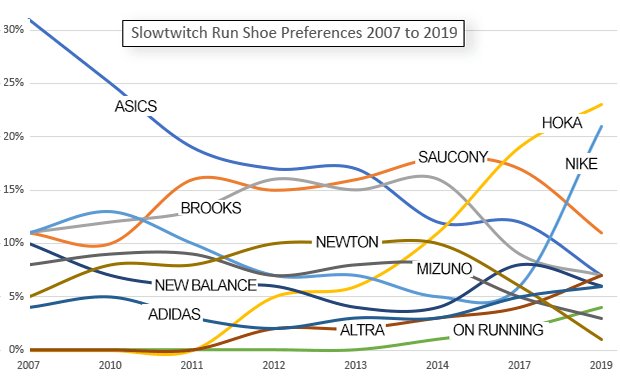
The New York Times published a handful of days ago, on December 13th, a study of shoe models. This was an update of a process begun the year before, where the two authors simply scoured STRAVA, looking for incidences of shoe model changes between a runner’s previous marathon and his or her subsequent marathon in a different shoe. The investigation, “now includes results from more than a million marathons and half marathons combined since 2014.” The study notes that STRAVA does not simply record times achieved by its users, but, “about one in four races includes self-reported information about a runner’s shoes.” Which shoes, when purchased, yielded the biggest increases in speed?
The answer, no surprise here, Nike Vaporfly 4% (pictured below) and Nike Next% give runners the biggest improvement, out of about 50 models tracked. To be clear, most runners improved their times when they changed shoes, but nothing benefitted runners’ finish times as much as these shoes. If the median time enhancement was (say) between 1.5 and 2.0 percent in time savings after switching shoes, these Nikes helped their runners to time improvements of between 4.5 and 5.0 percent.
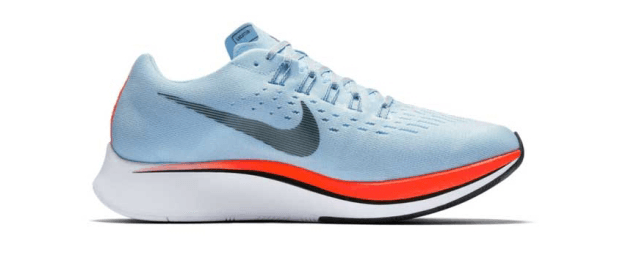
Shoe models that likewise did well were the Adidas Adizero, On Running Clowdflow, Newton Distance and models made by that brand started by the two Frenchmen: HOKA One One. But it was mostly what the authors labeled “HOKA Carbon” that yielded a time benefit, which I take to mean both the Carbon X and the EVO Carbon Rocket (almost an ounce and a half lighter than the Carbon X).
Can we pan out a bit? Look at what I think is really happening here?
It’s not the “carbon plate.” Not that alone. We can’t simply say that if you slip a carbon plate in the midsole of a shoe that this is what speeds it up. The latest high-end midsole foams are at least as impactful, specifically because they’re unimpactful: This new foam material, PEBA versus EVA, while increasing energy return (I take this to mean more elastic, less damping), also “deconflicts” the collision between body and ground. (Carbon plated shoes, meanwhile, have been around since the 1980s). I don’t mean to dismiss carbon plates; rather to place them in what seems to me their proper scale.
Also in the New York Times, from this past October, was a column by Amby Burfoot entitled, Those Superfast Nike Shoes are Creating a Problem. He appears to endorse elite marathoner and biomechanics doctoral candidate Geoffrey Burns’s call for “a single standard in competition running shoes: regulate the shoe midsole thickness.” That proposed max allowable (for records at least, if not for podiums) thickness? 31mm. Burfoot mentions that “Nike’s current Vaporfly 4% and Vaporfly Next% shoes have a 36-millimeter midsole.”
(And, by the way, if you look at the diagrams that attach to these various studies that end up endorsing a 31mm max midsole, it really isn't the midsole they're talking about; it's the entire shoe height, midsole + outsole.)
Couple of notes on this. First, Amby! Yes! Big cushion works! Where’ve you been the last 9 years?
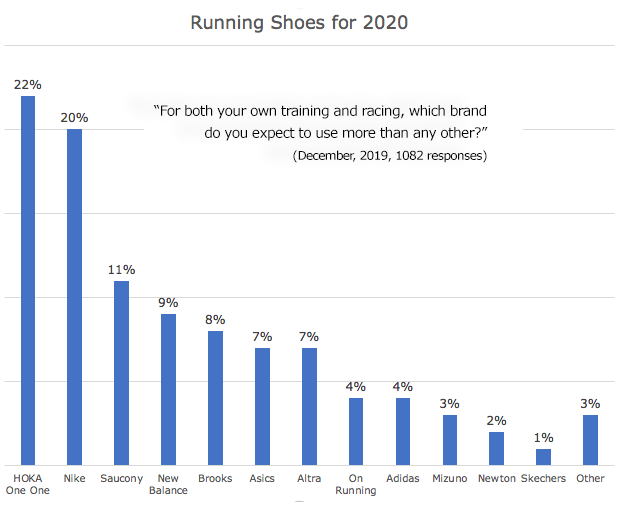
Second, see above for what you all prefer for your run shoes, as of this past week. This closely mirrors what Dave Jewell counted at Ironman Arizona last month, and what we saw you all ran in in Kona. What do Nike and HOKA have in common? Not simply carbon plates, and often you all choose HOKAs and Nikes with no plates at all. You also don't always choose shoes with PEBA foam. If HOKA closed the gap in the foam wars I missed it. The Carbon X features, from HOKA’s website, “resilient EVA compound that sits above the carbon plate and injected rubberized EVA below the plate.”
Nevertheless, I race in the Carbon X [mine are below], choosing it over the Nikes for reasons I’ve discussed when writing about the relevant shoe models. It’s not simply the particular chemical construction of foam that’s pushing both shoe brands up in the preference rankings. And it’s not just the promise of fast times. Slowtwitcher Benjamin Deal raced to a rockin' good 4th place overall at the Indian Wells 70.3 last month, throwing down a virtual run-split tie with race winner Lionel Sanders (mid-1:12 half-marathon), and here’s what he wrote on our Reader Forum 4 weeks before that race:
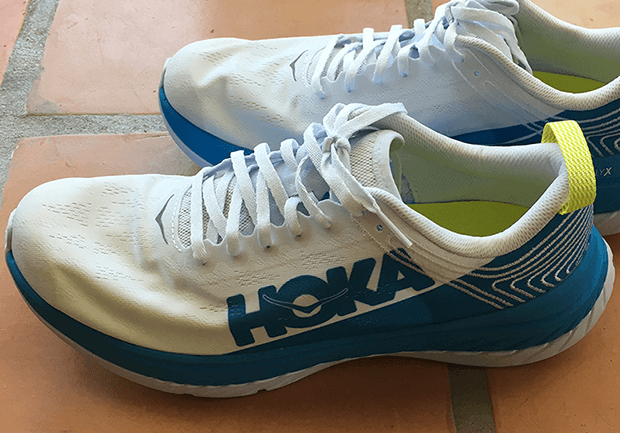
“My legs are noticeably and significantly less sore overall after racing/working out in them. After every race I would suffer from some extreme, almost debilitating calf tightness for 2-3 days. There was none of that after Waco. Honestly I'm not sure I feel faster in them, but for the reduced leg pain in the days following, they have been totally worth it so far.”
That said, Ben succumbed and raced Indian Wells on a pair of Next%. But I asked him about the style of these shoes. Whether the point of both the Next% and the Carbon X was similar. “Absolutely. It’s like my Achilles had hardened and would not stretch at all,” the day after racing in a typical flat. “For 4 days I would be walking with a pretty solid limp. This had happened after every race since St. George this year [Eagleman, Boulder, Santa Cruz]. Then Waco came with the Hokas and it just didn't happen. Just normal lower leg soreness, though maybe slightly higher beating on the quads. And essentially the same thing, but without the increased load on the quads and the foot pain in Indian Wells.”
What are the themes common to both HOKA and Nike’s new shoes that have captured the imagination, the spendable dollars, and the loyalty of users?
Energy Absorption & Return
I wrote about PEBA foam when I overviewed the new Saucony Endorphin Collection. PEBA stands for Polyether Block Amide, and it is fast replacing EVA – Ethyl Vinyl Acetate – as the midsole foam of choice. Burfoot mentions in his NYT article that “Pebax also delivers 30 percent more energy return than the foams used in most running shoes since the 1970s.” Pebax is a foam maker’s brand name for its PEBA foam.
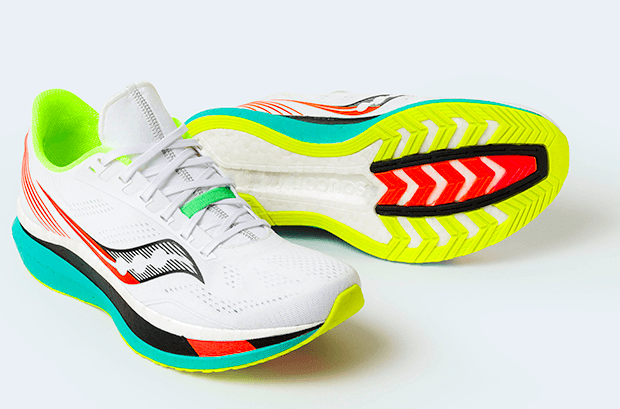
Certainly PEBA is a killer app. But it’s not the foam itself that is the theme here. It’s what the foam does. Runners have spent this entire decade teaching the industry what they want, with triathletes leading the charge. The better your legs feel, the faster you go, the more miles you run, the better you recover. Is it a coincidence that Altra has been steadily climbing in Slowtwitch user preference at the same time its only shoe with a heel height more than 30mm (the Paradigm) was joined by the Duo and Olympus? Altra’s light train/race shoes, like the Escalante, now have the same height as this brand’s Paradigm trainer did earlier in the decade.
Forefoot Cushion
It might be obvious to us all now, but HOKA got a lot of pushback in the first half of the decade, both from minimal/naturalists, and from the Newton narrative that (as I recall it) emphasized the foot’s connection with the ground, which communicates with the 200,000 nerves that exist in the human foot, and which excessive cushion compromised (according to Newton’s narrative at the time, as I understood it).
In short, the run industry fought tooth and nail (my takeaway simply based on the shoes it kept producing) against plush cushion in general and forefoot cushion in particular. Runners may have thought they responded to low-drop (as with Altra, Innov8 and HOKA). In my opinion, it wasn’t dropping the heel that runners resonated with. In shoes that sold well it was raising the forefoot.
As an example, Altra and Innov8 both featured low-stack shoes. Altra, over the past 3 or 4 years, at least in some models, raised the entire shoe. Innov8, not so much. I note the difference in the user preference among Slowtwitchers between Altra and Innov8. I don’t know if that’s causation or correlation.
Eliminating Brake Rub
For years ASICS fought the idea of forefoot cushion, positing that runners were heel strikers, that’s what mattered, that’s what their research showed, that’s all we need to know. In my opinion, ASICS was helping that narrative along by making shoes that pretty much guaranteed that more force would come down on the heel. As I’ve been writing for years, it’s possible to guarantee this: Run in pumps! The higher the heel, the lower the forefoot, and the less sculpted the heel’s outsole, the more heelstrike self-fulfills. Look at these Nikes below:
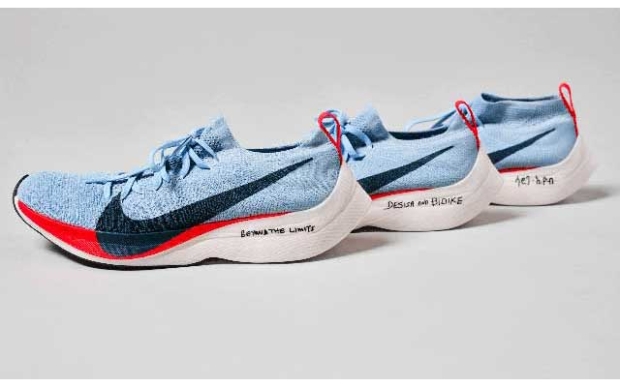
This outsole geometry gets rid of the brake rub. Gets rid of the friction between heel and ground at contact. Or, if not ridding the shoe of that heel scrape entirely, at least lessens it.
Do we like it when our brakes rub on our bikes? if not, why do we think it’s okay during the run?
Advanced (and Advancing) Geometry
The geometry in the shoe above also promotes a clean transition from heelstrike to toe-off. HOKA called it the Meta-Rocker in 2010. Saucony, for its new Endorphin Collection, calls it the Speedroll Geometry. I’m confident each brand would say that what it is talking about is different from what the other is talking about. If so, fine. But just look at all these shoes!
It’s pretty clear to me that each brand’s shoes seeks to get the shoe out of the way of the runner’s mission, which is to land=> pivot=> go. These shoes just look so different than what we’re used to, the outsole forming a parabola.
If you think about it, Newton also sits into this, and championed the idea (whether or not it used this narrative) before other shoes. I wrote about fulcrums 5 years ago, and below is the image I used to illustrate this:
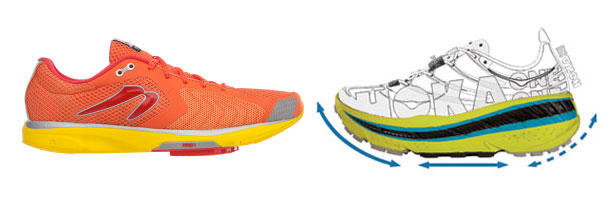
If you took some Shoe Goo and filled in the area between the Newton’s outsole and the lug, would you have a geometry markedly different in use case than today’s shoes? Simply as a casual observer, the rest of the world is catching up.
STRAVA Study Takeaways
I’ve been a HOKA devotee since 2010. If you look at the recent New York Times article referencing this exhaustive STRAVA survey, data is parsed four ways: Using statistical models; Studying groups of runners who ran the same pair of races; Following runners as they switch shoes; Measuring the likelihood of a personal record in a pair of shoes.
The HOKA Bondi came out last – slowest – of the 50 or so models tested, in 3 of the 4 ways the data was parsed. That’s not fair to the Bondi, in my opinion, because someone changing to a 7.5 ounce shoe (like a Nike a Next%) is moving to a race shoe, whereas someone moving to a Bondi is moving to a shoe that’s 3 ounces heavier. You could look at that list of 50 shoes and there’s a close correlation to weight (switching to HOKA’s Clifton is much better in the NYT overview than the Bondi; the Carbon X is better than the Clifton; the Next% better than the Carbon X; and each is an ounce or so lighter than the next.
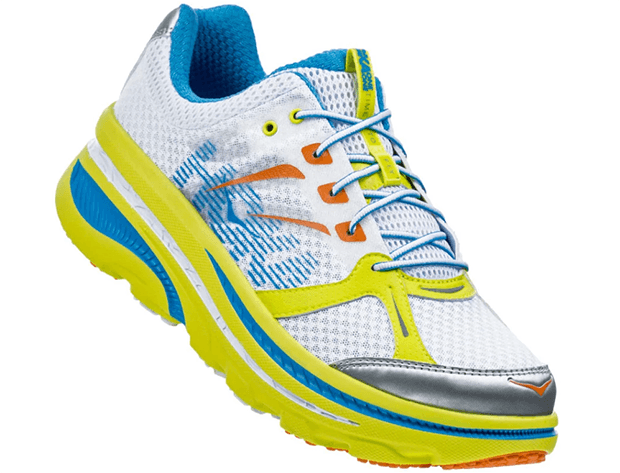
That said, the Bondi is the one shoe HOKA makes of which I’ve been critical, because in my opinion HOKA has let the Bondi drift from its original use case (I believe many of us run in the reissued original Bondi B, pictured above, from 9 years ago, choosing it over the current Bondi 6; I certainly do). What we now see is that Nike, Altra, and Saucony’s Endorphin Collection have come in HOKA’s direction. But there’s more that I need in a shoe than just cushion. There’s HOKA’s “bucket seat” architecture, which I get in most of its shoes, but I used that same terminology when describing the new Saucony Endorphins. There’s HOKA’s Meta-Rocker but other shoe makers are finally on to this.
What I’m glad of is that the themes that animated me when HOKA first came out are now – finally! – getting the recognition they deserve, not just in words but in shoes. I’ll be testing out some Salomon Sense Ride 3 (not out yet). And the Saucony Endorphin Shift when I can get my feet into some. And the new ASICS models (Metaride and Glideride) that feature a design that veers from what I take to have been this brand's narrative for so long.


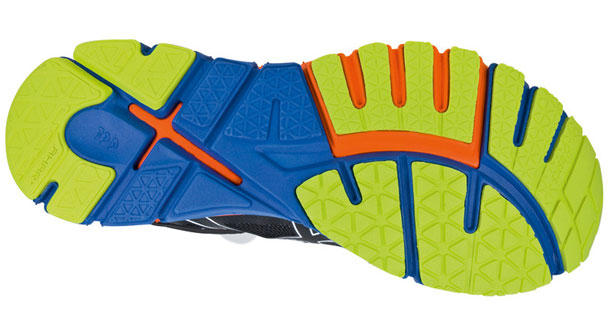
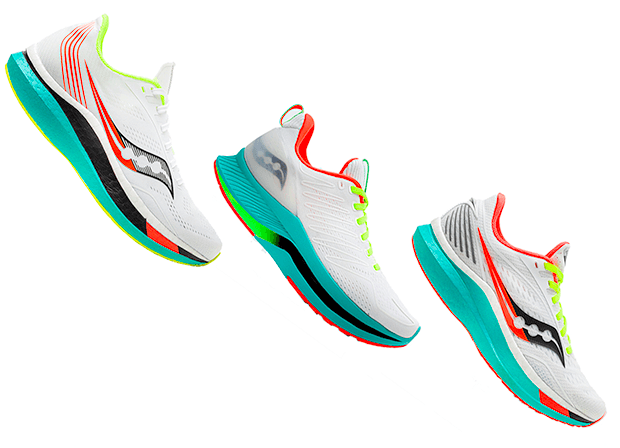
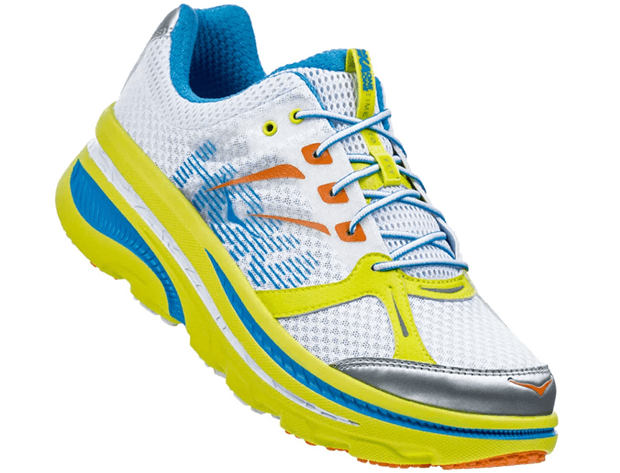
Start the discussion at slowtwitch.northend.network